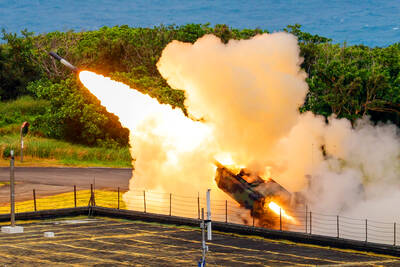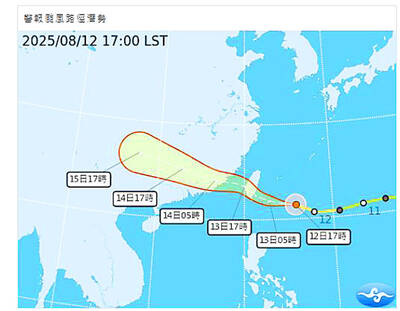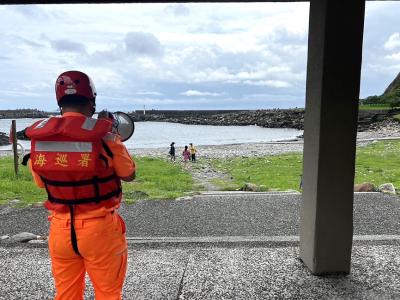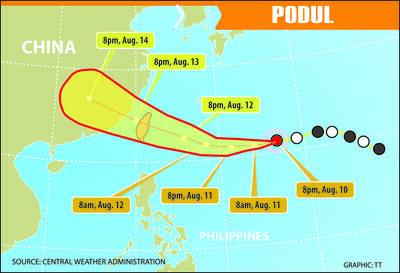China yesterday countered US President Donald Trump’s across-the-board tariffs on Chinese products with tariffs on select US imports, as well as announcing an antitrust investigation into Google and other trade measures.
US tariffs on products from Canada and Mexico were also set to go into effect yesterday before Trump agreed to a 30-day pause, as the two countries acted to appease his concerns about border security and drug trafficking.
Trump planned to talk with Chinese President Xi Jinping (習近平) in the next few days.

Photo: EPA-EFE
China said it would implement a 15 percent tariff on coal and liquefied natural gas (LNG) products, as well as a 10 percent tariff on crude oil, agricultural machinery and large-engine vehicles imported from the US. The tariffs are to take effect on Monday next week.
“The US’ unilateral tariff increase seriously violates the rules of the World Trade Organization,” the Chinese State Council Tariff Commission said in a statement. “It is not only unhelpful in solving its own problems, but also damages normal economic and trade cooperation between China and the US.”
The impact on US exports might be limited. Although the US is the biggest exporter of LNG, it does not export much to China. In 2023, the US exported 4,906 million cubic meters of LNG to China, or about 2.3 percent of total natural gas exports, US Energy Information Administration data showed.
China imported only about 700,000 vehicles overall last year, mainly from Europe and Japan, said Bill Russo, the founder of the Automobility Ltd consultancy in Shanghai.
China also announced export controls on several elements critical to the production of modern high-tech products. They include tungsten, tellurium, bismuth, molybdenum and indium, many of which are designated as critical minerals by the US Geological Survey, meaning they are essential to US economic or national security that have supply chains vulnerable to disruption. The export controls are in addition to ones China placed in December on key elements such as gallium.
In addition, the Chinese State Administration for Market Regulation yesterday said it is investigating Google on suspicion of breaching antitrust laws. The announcement did not mention the tariffs, but came just minutes after Trump’s 10 percent tariffs on China were to take effect.
It was unclear how the probe would affect Google’s operations.
The company has long faced complaints from Chinese smartphone makers over its business practices surrounding the Android operating system, said John Gong, a professor at the University of International Business and Economics in Beijing.
Otherwise, Google has a limited presence in China, and its search engine is blocked in the country like most other Western platforms. Google did not immediately comment.
The Chinese Ministry of Commerce also placed two US companies on an unreliable entities list: PVH Group, which owns Calvin Klein and Tommy Hilfiger, and Illumina, which is a biotechnology company with offices in China.
The listing could bar them from engaging in China-related import or export activities and from making new investments in the country.
Beijing began investigating PVH Group in September last year over “improper Xinjiang-related behavior” after the company allegedly boycotted the use of Xinjiang cotton.

DEFENSE: The first set of three NASAMS that were previously purchased is expected to be delivered by the end of this year and deployed near the capital, sources said Taiwan plans to procure 28 more sets of M-142 High Mobility Artillery Rocket Systems (HIMARS), as well as nine additional sets of National Advanced Surface-to-Air Missile Systems (NASAMS), military sources said yesterday. Taiwan had previously purchased 29 HIMARS launchers from the US and received the first 11 last year. Once the planned purchases are completed and delivered, Taiwan would have 57 sets of HIMARS. The army has also increased the number of MGM-140 Army Tactical Missile Systems (ATACMS) purchased from 64 to 84, the sources added. Each HIMARS launch pod can carry six Guided Multiple Launch Rocket Systems, capable of

GET TO SAFETY: Authorities were scrambling to evacuate nearly 700 people in Hualien County to prepare for overflow from a natural dam formed by a previous typhoon Typhoon Podul yesterday intensified and accelerated as it neared Taiwan, with the impact expected to be felt overnight, the Central Weather Administration (CWA) said, while the Directorate-General of Personnel Administration announced that schools and government offices in most areas of southern and eastern Taiwan would be closed today. The affected regions are Tainan, Kaohsiung and Chiayi City, and Yunlin, Chiayi, Pingtung, Hualien and Taitung counties, as well as the outlying Penghu County. As of 10pm last night, the storm was about 370km east-southeast of Taitung County, moving west-northwest at 27kph, CWA data showed. With a radius of 120km, Podul is carrying maximum sustained

Tropical Storm Podul strengthened into a typhoon at 8pm yesterday, the Central Weather Administration (CWA) said, with a sea warning to be issued late last night or early this morning. As of 8pm, the typhoon was 1,020km east of Oluanpi (鵝鑾鼻), Taiwan’s southernmost tip, moving west at 23kph. The storm carried maximum sustained winds of 119kph and gusts reaching 155kph, the CWA said. Based on the tropical storm’s trajectory, a land warning could be issued any time from midday today, it added. CWA forecaster Chang Chun-yao (張竣堯) said Podul is a fast-moving storm that is forecast to bring its heaviest rainfall and strongest

TRAJECTORY: The severe tropical storm is predicted to be closest to Taiwan on Wednesday and Thursday, and would influence the nation to varying degrees, a forecaster said The Central Weather Administration (CWA) yesterday said it would likely issue a sea warning for Tropical Storm Podul tomorrow morning and a land warning that evening at the earliest. CWA forecaster Lin Ting-yi (林定宜) said the severe tropical storm is predicted to be closest to Taiwan on Wednesday and Thursday. As of 2pm yesterday, the storm was moving west at 21kph and packing sustained winds of 108kph and gusts of up to 136.8kph, the CWA said. Lin said that the tropical storm was about 1,710km east of Oluanpi (鵝鑾鼻), Taiwan’s southernmost tip, with two possible trajectories over the next one